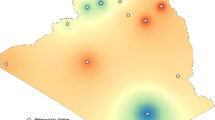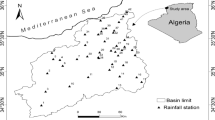Abstract
Climate change affects the hydrological cycle and has a significant influence on water resources, which can lead to environmental and socioeconomic damage caused by droughts. This phenomenon has become more acute in recent years. Among the indices used to assess the extent of droughts, the Reconnaissance Drought Index (RDI) is being adopted throughout the world. The RDI requires a stationarity assumption in its statistical calculations; however, most of the hydro-meteorological time series show non-stationarity. Hence, this paper seeks to assess meteorological droughts by means of RDI by adopting both stationary and non-stationary approaches. Non-stationarity was assessed by applying the Mann–Kendall test for trend detection and the Pettitt test for change point detection. The Thornthwaite method was employed to estimate the potential evapotranspiration required for RDI application. The bias in the future series were corrected employing the Linear Scaling (LS) technique for precipitation series and the Empirical Quantile Mapping (EQM) technique for the temperature series. Historical and future simulated monthly temperature and precipitation data were obtained from 34 meteorological stations located within Parana State, Brazil. The results showed that the maximum drought magnitude, duration, and intensity have increased during the 21st Century. When compared with historical patterns up to 2100, the results showed that drought magnitude is expected to increase by 105%, while drought duration is expected to increase by 59% in meteorological drought projections.




Similar content being viewed by others
Availability of Data
Both the precipitation and temperature data used in this research are restricted to the purposes of this study and to the doctoral dissertation. Restricted historical data on precipitation and temperature were provided by the Parana Agronomic Institute (IAPAR).
Change history
07 July 2022
Figure 2 legend was placed below its image.
References
Alvares CA, Stape JL, Sentelhas PC et al (2013) Köppen’s climate classification map for Brazil. Meteorol Zeitschrift 22:711–728
Andrade CWL, Montenegro SMGL, Montenegro AAA, Lima JRS, Srinivasan R, Jones CA (2020) Climate change impact assessment on water resources under RCP scenarios: A case study in Mundaú River Basin, Northeastern Brazil. Int J Climatol 1–17
ANEEL – Agência Nacional de Energia Elétrica (The Brazilian National Enectrical Energy Agency) (2022) ANEEL’s generation information system (in Portuguese). https://bit.ly/2IGf4Q0. Accessed 15 Feb 2022
Awange JL, Mpelasoka F, Goncalves RM (2016) When every drop counts: Analysis of Droughts in Brazil for the 1901–2013 period. Sci Total Environ 566–567:1472–1488
Bazrafshan J, Hejabi S (2018) A non-stationary reconnaissance drought index (NRDI) for Drought monitoring in a changing climate. Water Resour Manag 32(8):2611–2624
Brito SSB, Cunha APMA, Cunningham CC et al (2018) Frequency, duration and severity of drought in the Semiarid Northeast Brazil region. Int J Climatol 38:517–529
Canambra Engineering Consultants Limites (1969) Estudos Energéticos da Região Sul do Brasil – Sumário do Relatório Final
Chattopadhyay S, Edwards DR, Yu Y, Hamidisepehr A (2017) An assessment of climate change impacts on future water availability and droughts in the Kentucky river basin. Environ Process 4:477–507
Cheng L, Aghakouchak A (2014) Nonstationary precipitation intensity-duration-frequency curves for infrastructure design in a changing. Sci Rep 7093:1–6
Collischonn W, Marengo JA, Marangon Lima LM (2014) Impacto das mudanças climáticas na geração hidrelétrica, 1st edn. Brasília, DF
COMEC (Commission of the European Communities) (2007) Communication from the commission to the European parliament and the council: addressing the challenge of water scarcity and droughts in the European Union. Brussels
Cunha APMA, Zeri M, Leal KD et al (2019) Extreme drought events over Brazil from 2011 to 2019. Atmosphere (Basel) 10
Dai A (2011) Drought under global warming: A review. Wiley Interdiscip Rev Clim Chang 2:45–65
Das J, Jha S, Goyal M (2020) Non-stationary and copula-based approach to assess the drought characteristics encompassing climate indices over the Himalayan states in India. J Hydrology 580
Das J, Umamahesh NV (2016) Downscaling monsoon rainfall over river godavari basin under different climate-change scenarios. Water Resour Manag 30:5575–5587
Detzel DHM, Filho LRM, Rangel LMÁ et al (2019) Acerca Do Período Crítico Das Usinas Hidrelétricas Brasileiras. In XXIII Simpósio Brasileiro de Recursos Hidrícos Acerca. Foz do Iguaçu, PR, pp 1–10
Fang GH, Yang J, Chen YN, Zammit C (2015) Comparing bias correction methods in downscaling meteorological variables for a hydrologic impact study in an arid area in China. Hydrol Earth Syst Sci 19:2547–2559
Gohar AA, Cashman A (2018) The economic value of groundwater irrigation for food security under climate change: Implication of representative concentration pathway climate scenarios. Water Resour Manag 32:3903–3918
Gu L, Chen J, Xu CY et al (2019) The contribution of internal climate variability to climate change impacts on droughts. Sci Total Environ 684:229–246
Hao Z, AghaKouchak A (2013) Multivariate standardized drought index: A parametric multi-index model. Adv Water Resour 57:12–18
Hao Z, Singh VP (2015) Drought characterization from a multivariate perspective: A review. J Hydrol 527:668–678
He B, Chang J, Wang Y, Wang Y, Zhou S, Chen C (2021) Spatio-temporal evolution and non-stationary characteristics of meteorological drought in inland arid areas. Ecol Indic 126
IBGE (2022) Dados estatísticos do Paraná. Rio de Janeiro, Rio de Janeiro
Jehanzaib M, Shah S, Yoo J, Kim T (2020) Investigating the impacts of climate change and human activities on hydrological drought using non-stationary approaches. J Hydrol 588
Jehanzaib M, Yoo J, Kwon H, Kim T (2021) Reassessing the frequency and severity of meteorological drought considering non-stationarity and copula-based bivariate probability. J Hydrology 603
Kendall MG, Stuart A (1963) The advanced theory of statistics, 2nd edn. American Statistical Association, Glasgow
Kirono DGC, Kent DM, Hennessy KJ, Mpelasoka F (2011) Characteristics of Australian droughts under enhanced greenhouse conditions: Results from 14 global climate models. J Arid Environ 75:566–575
Kopsiaftis G, Tigkas D, Christelis V, Vangelis H (2017) Assessment of drought impacts on semi-arid coastal aquifers of the Mediterranean. J Arid Environ 137:7–15
Koutsoyiannis D (2006) Nonstationarity versus scaling in hydrology. J Hydrol 324:239–254
Lenderink G, Buishand A, van Deursen W (2007) Estimates of future discharges of the river Rhine using two scenario methodologies: direct versus delta approach. Hydrol Earth Syst Sci 3:1145–1159
Li B, Liang Z, Zhang J, Wang G (2017) A revised drought index based on precipitation and pan evaporation. Int J Climatol 37:793–801
Lucena AFP, Kober T, Köberle AC et al (2018) Interactions between climate change mitigation and adaptation: The case of hydropower in Brazil. Energy 164:1161–1177
Maack R (2002) Geografia física do Estado do Paraná, 3rd ed. Imprensa Oficial do Paraná, Curitiba
Mann HB (1945) Nonparametric Tests Against Trend. Econometrica 13:245–259
Marengo JA, Cunha AP, Soares WR et al (2019) Increase Risk of Drought in the Semiarid Lands of Northeast Brazil Due to Regional Warming above 4 °C. 181–200
McKee TB, Doesken NJ, Kleist J (1993) The relationship of drought frequency and duration to time scales. In: Proceedings of the Eighth Conference on Applied Climatology, Anaheim, CA. Am Metereological Soc 179–184.
MMA (2016) Ministério do Meio Ambiente. Cadastro nacional de unidades de conservação, Brasília, DF, Brazil
Mohammed R, Scholz M (2017) Impact of evapotranspiration formulations at various elevations on the reconnaissance drought index. Water Resour Manag 31:531–548
Nam WH, Hayes MJ, Svoboda MD et al (2015) Drought hazard assessment in the context of climate change for South Korea. Agric Water Manag 160:106–117
Park CE, Jeong SJ, Joshi M et al (2018) Keeping global warming within 1.5 °C constrains emergence of aridification. Nat Clim Chang 8:70–74
Ploszai R, Mine MRM (2016) Rainfall trend analysis in the region of Curitiba using regional climate model scenarios. Green Energy Technol 193–208
Porto de Carvalho JR, Delgado Assad E, Medeiros Evangelista SR, Da Silveira PH (2013) Estimation of dry spells in three Brazilian regions - Analysis of extremes. Atmos Res 132–133:12–21
Rashid MM, Beecham S (2019) Development of a non-stationary Standardized Precipitation Index and its application to a South Australian climate. Sci Total Environ 657:882–892
Rougé C, Ge Y, Cai X (2013) Detecting gradual and abrupt changes in hydrological records. Adv Water Resour 53:33–44
Salas JD, Rajagopalan B, Saito L, Brown C (2012) Special section on climate change and water resources: Climate nonstationarity and water resources management. J Water Resour Plan Manag 138:385–388
Sheffield J, Wood EF (2008) Projected changes in drought occurrence under future global warming from multi-model, multi-scenario, IPCC AR4 simulations. Clim Dyn 31:79–105
Soriano É, Londe LDR, Di Gregorio LT et al (2016) Water Crisis in São Paulo Evaluated Under the Disaster ’ S Point of View 1. Ambient e Soc XIX:21–42
Spinoni J, Naumann G, Carrao H et al (2014) World drought frequency, duration, and severity for 1951–2010. Int J Climatol 34:2792–2804
Teutschbein C, Seibert J (2012) Bias correction of regional climate model simulations for hydrological climate-change impact studies: Review and evaluation of different methods. J Hydrol 456–457:12–29
Tigkas D, Vangelis H, Tsakiris G (2012) Drought and climatic change impact on streamflow in small watersheds. Sci Total Environ 440:33–41
Touma D, Ashfaq M, Nayak MA et al (2015) A multi-model and multi-index evaluation of drought characteristics in the 21st century. J Hydrol 526:196–207
Tsakiris G, Nalbantis I, Pangalou D et al (2008) Drought meteorological monitoring network design for the reconnaissance drought index (RDI). Res Options Méditerranéennes Ser A 80:57–62
Tsakiris G, Pangalou D, Vangelis H (2007) Regional drought assessment based on the Reconnaissance Drought Index (RDI). Water Resour Manag 21:821–833
Tsakiris G, Vangelis H (2005) Establishing a drought index incorporating evapotranspiration. Eur Water 9:3–11
Vangelis H, Tigkas D, Tsakiris G (2013) The effect of PET method on Reconnaissance Drought Index (RDI) calculation. J Arid Environ 88:130–140
Wang Y, Duan L, Liu T, Li J, Feng P (2020) A Non-stationary Standardized Streamflow Index for hydrological drought using climate and human-induced indices as covariates. Sci Total Environ 699
Wilhite DA (2000) Drought as a natural hazard. Drought: A global assessment. University of Nebraska, London, pp 147–162
Yilmaz AG, Perera BJC (2014) Extreme rainfall nonstationarity investigation and intensity – frequency – duration relationship. J Hydrol Eng 19:1160–1172
Zarch MAA, Malekinezhad H, Mobin MH et al (2011) Drought monitoring by reconnaissance drought index (RDI) in Iran. Water Resour Manag 25:3485–3504
Zarch MAA, Sivakumar B, Sharma A (2015) Droughts in a warming climate: A global assessment of Standardized precipitation index (SPI) and Reconnaissance drought index (RDI). J Hydrol 526:183–195
Zhang X, Wang J, Zwiers FW, Groisman PY (2010) The influence of large-scale climate variability on winter maximum daily precipitation over North America. J Clim 23:2902–2915
Zou L, Xia J, She D (2018) Analysis of impacts of climate change and human activities on hydrological Drought: A case study in the Wei River Basin. China. Water Resour Manag 32(4):1421–1438
Acknowledgements
The authors would like to thank the following government agencies in Brazil: National Institute of Meteorology, Parana Agronomic Institute, National Water and Sanitation Agency and National Institute for Spatial Research, for providing the data needed to carry out the PhD thesis and the research for this work. The first author is grateful to the Coordination for the Improvement of Higher Education Personnel (CAPES) for funding this PhD research study.
Funding
The first author was awarded a grant to undertake his PhD research by the Coordination for the Improvement of Higher Education Personnel (CAPES).
Author information
Authors and Affiliations
Corresponding author
Ethics declarations
Conflicts of Interest/Competing Interests
Not applicable.
Additional information
Publisher's Note
Springer Nature remains neutral with regard to jurisdictional claims in published maps and institutional affiliations.
Rights and permissions
About this article
Cite this article
Ploszai, R., Mine, M.R.M. & Detzel, D.H.M. An Analysis of Non-stationary Drought Conditions in Parana State Based on Climate Change Scenarios. Water Resour Manage 36, 3401–3415 (2022). https://doi.org/10.1007/s11269-022-03143-y
Received:
Accepted:
Published:
Issue Date:
DOI: https://doi.org/10.1007/s11269-022-03143-y




